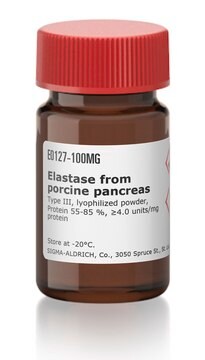C2799
Collagenase from Clostridium histolyticum
powder, suitable for cell culture, ≥4 FALGPA units/mg solid, high purity, ≥700 CDU/mg solid (CDU = collagen digestion units)
Synonym(s):
Clostridiopeptidase A
About This Item
Recommended Products
biological source
Clostridium histolyticum
Quality Level
form
powder
specific activity
≥4 FALGPA units/mg solid
≥700 CDU/mg solid (CDU = collagen digestion units)
mol wt
68-130 kDa
purified by
chromatography
technique(s)
cell culture | mammalian: suitable
pH
7.4
foreign activity
neutral protease and clostripain ≤1 unit/mg solid
shipped in
dry ice
storage temp.
−20°C
Looking for similar products? Visit Product Comparison Guide
Application
Biochem/physiol Actions
Caution
Unit Definition
Preparation Note
related product
substrate
Signal Word
Danger
Hazard Statements
Precautionary Statements
Hazard Classifications
Eye Irrit. 2 - Resp. Sens. 1 - Skin Irrit. 2 - STOT SE 3
Target Organs
Respiratory system
Storage Class Code
11 - Combustible Solids
WGK
WGK 1
Flash Point(F)
Not applicable
Flash Point(C)
Not applicable
Choose from one of the most recent versions:
Already Own This Product?
Find documentation for the products that you have recently purchased in the Document Library.
Customers Also Viewed
Our team of scientists has experience in all areas of research including Life Science, Material Science, Chemical Synthesis, Chromatography, Analytical and many others.
Contact Technical Service






